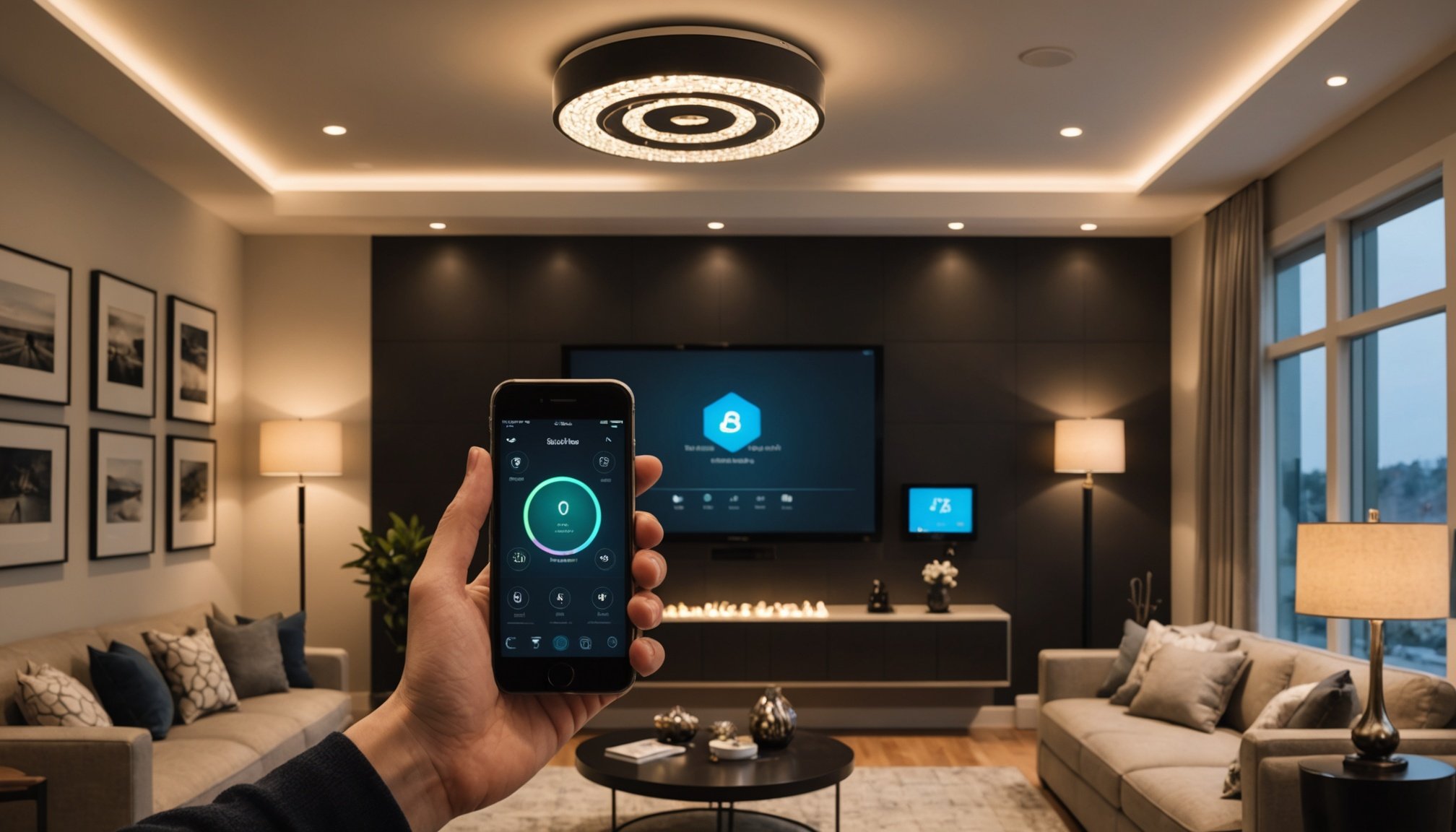Understanding Smart Lighting Technology
Smart lighting is revolutionising the way we illuminate our homes, offering an array of possibilities for enhancing both functionality and ambiance. At its core, smart lighting technology consists of intelligent lighting fixtures that can be controlled remotely via smartphones, voice assistants, or other connected devices. These systems often incorporate sensors and wireless communication to seamlessly integrate with home automation platforms, allowing for comprehensive management of lighting across the household.
One of the key benefits of integrating smart lighting into home spaces is the ability to create personalised lighting scenes. Homeowners can adjust the intensity, colour, and scheduling of their lights to suit specific activities or moods, enhancing the overall ambiance of each room. Additionally, smart lighting can significantly improve energy efficiency by allowing precise control over when and how lights are used, reducing unnecessary consumption.
Also to read : Revamp your environment: utilize your smartphone to create a smart home fitness area
Current trends in the smart lighting arena are focusing on greater interoperability and enhanced user experiences. There is a growing emphasis on energy conservation, with features like adaptive lighting that automatically adjusts based on available daylight. Voice control capabilities and integration with smart home assistants are also expanding, making it easier for users to interact with and optimise their lighting environment without hassle.
Smartphone Integration Techniques
For the seamless integration of smartphone controls in smart lighting systems, an app’s functionality is crucial. This integration depends on several factors.
Also read : Smart home control: optimize your water filtration system with your smartphone
Compatible Platforms and Applications
Choosing a smart lighting system with broad platform compatibility is vital for user-friendly design. Look for systems that support both iOS and Android platforms to ensure you can manage your lights across different devices. Leading apps like Philips Hue or LIFX offer robust compatibility, which enhances the control flexibility for various smartphones, ensuring you have more options at your fingertips.
Feature Set of Leading Smart Lighting Apps
Modern app functionality has advanced, providing features such as scheduling, mood lighting presets, and even voice control integrations. These apps often allow remote control, so you can manage your lights even when away from home. Top apps also offer advanced automation settings, using sensors to react to environmental conditions automatically, delivering convenience.
User Experience Considerations
An intuitive app design plays a significant role in how users interact with smart lighting. A well-designed app will be easy to navigate, making its user-friendly design a pleasure. Cross-platform compatibility can significantly enhance user experience, ensuring functionality and accessibility regardless of your device. Popular apps that achieve this offer comprehensive tutorials and support, making the transition to smart lighting smoother.
Automated Control Options
Efficient automation in smart homes can significantly enhance daily life, providing convenience and energy savings. One intriguing method involves setting up schedules for smart lighting. This allows the system to adapt lighting based on your daily routines, ensuring perfect illumination at any time of day or night. By utilizing smart home systems, users can manage schedules efficiently, making their homes truly intuitive.
Moreover, employing sensors takes automation a step further by allowing for automatic adjustments. For instance, sensors can detect the level of natural light and adjust indoor lighting accordingly. This type of control helps create an optimal environment without manual intervention, contributing to both comfort and energy efficiency.
Integrating various smart devices into a cohesive system further amplifies the benefits of automation. Imagine your lights, thermostat, and security system working harmoniously through one smart home system. Such integration not only offers seamless control but also opens possibilities for advanced features like voice commands and remote access via smartphone apps.
These smart home systems provide customizable settings that enhance your living space, ensuring everyday tasks are executed automatically and effortlessly. The shift towards automation is undoubtedly a forward-thinking approach, aligning homes with the future of technology.
Product Recommendations
In the evolving world of smart light products, selecting the best option can be quite overwhelming. With a variety of products flooding the market, making informed choices is vital for enhancing your home with cutting-edge technology.
Top Smart Bulbs on the Market
Smart bulbs have revolutionized household lighting, offering features like remote control, color changes, and energy efficiency. Popular options include bulbs compatible with Amazon Alexa and Google Assistant, providing seamless integration with your smart home. Comparisons in reviews highlight factors like brightness, range of colors, and ease of installation. Consider how reviews emphasize the importance of energy-saving capabilities and whether they can be scheduled or controlled remotely.
Best Smart Light Switches
Smart light switches offer a sophisticated alternative to traditional ones, enabling effortless control over lighting through smartphone apps or voice commands. Reviews often compare functionalities such as compatibility with home networks, ease of installation, and reliability. The best switches stand out for their user-friendly interfaces and the ability to integrate with other smart devices seamlessly.
Smart LED Strips and Accessories
Smart LED strips are praised in reviews for their versatility in enhancing ambiance. They can be used creatively around mirrors, behind TVs, or even under cabinets. Key features that earn positive reviews include flexibility in length, color-changing ability, and synchronization with music or other smart devices.
Installation Tips for Smart Lighting
Installing smart lighting can be a DIY project if approached with the right guidelines. A step-by-step plan is crucial for efficiency.
First, begin by turning off the electrical power to ensure safety during installation. Safety is paramount, and it’s important to comply with all electrical safety standards to prevent hazards. Once the power is off, remove the existing switch or fixture. Carefully observe the wiring arrangement, taking note of the colors and connections.
Next, connect the smart lighting system following the manufacturer’s guidelines. Typically, this involves connecting the new wires to corresponding nodes, ensuring a secure and tight fit. If challenges arise, such as fitting issues or incompatible wiring, consult the manual or contact customer support for help. Many smart lighting products have support lines or online tutorials to guide you.
Once connected, turn the power back on and test your lighting system. It should be easily controllable from your smartphone or smart home device.
Lastly, compliance with local building codes is crucial to ensure safety standards are met. Improper installation can lead to malfunctions or even void warranties, so always adhere to the set safety codes and guidelines. With these steps, your DIY smart lighting installation can be both successful and safe.
Monitoring Features and Benefits
Smart lighting systems are revolutionising the way we interact with our home environment, offering a variety of monitoring features that provide substantial benefits. One principal advantage is the ability to track energy consumption. By monitoring energy use in real-time, homeowners can identify patterns and make informed adjustments to enhance energy efficiency, thus reducing electricity bills and environmental impact.
Additionally, smart lighting systems offer valuable usage insights, which play a crucial role in optimising lighting for mood and ambiance. For instance, by evaluating the frequency and duration of light use in different settings, users can tailor lighting conditions to suit different activities or times of day, creating a more comfortable and inviting atmosphere.
Beyond comfort, smart lighting systems significantly boost home security through monitoring. By simulating occupant presence with automated light schedules and receiving alerts for unusual lighting activity, homeowners can deter potential intruders, thereby increasing safety. Moreover, integrating these systems with other smart home devices enhances their capability of safeguarding your property.
In conclusion, the monitoring features offered by smart lighting systems provide homeowners with the tools necessary to achieve both energy efficiency and enhanced security, while optimising the ambiance of their living spaces.






